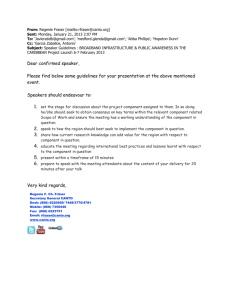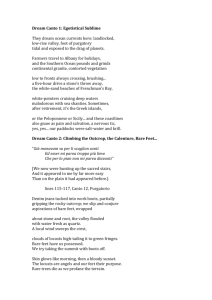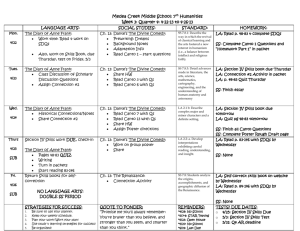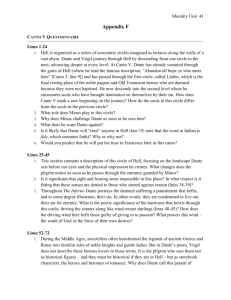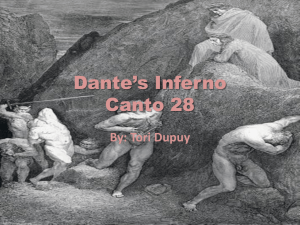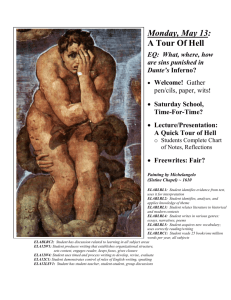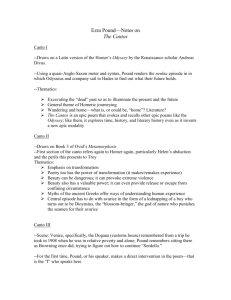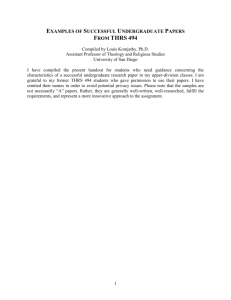Circle
advertisement
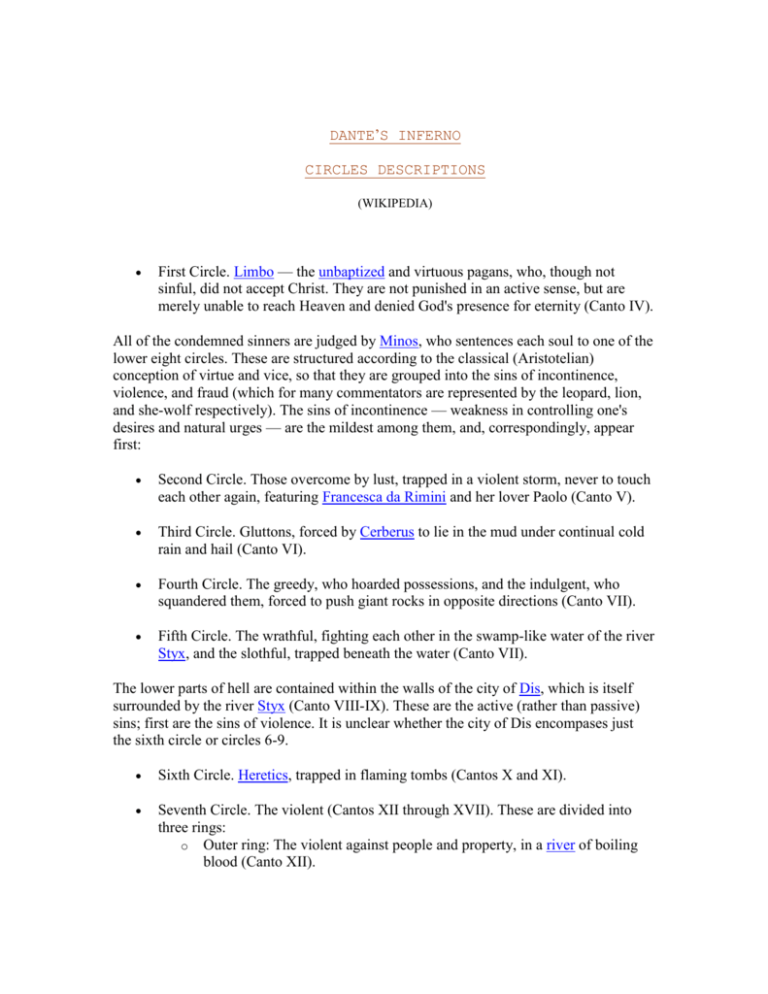
DANTE’S INFERNO CIRCLES DESCRIPTIONS (WIKIPEDIA) First Circle. Limbo — the unbaptized and virtuous pagans, who, though not sinful, did not accept Christ. They are not punished in an active sense, but are merely unable to reach Heaven and denied God's presence for eternity (Canto IV). All of the condemned sinners are judged by Minos, who sentences each soul to one of the lower eight circles. These are structured according to the classical (Aristotelian) conception of virtue and vice, so that they are grouped into the sins of incontinence, violence, and fraud (which for many commentators are represented by the leopard, lion, and she-wolf respectively). The sins of incontinence — weakness in controlling one's desires and natural urges — are the mildest among them, and, correspondingly, appear first: Second Circle. Those overcome by lust, trapped in a violent storm, never to touch each other again, featuring Francesca da Rimini and her lover Paolo (Canto V). Third Circle. Gluttons, forced by Cerberus to lie in the mud under continual cold rain and hail (Canto VI). Fourth Circle. The greedy, who hoarded possessions, and the indulgent, who squandered them, forced to push giant rocks in opposite directions (Canto VII). Fifth Circle. The wrathful, fighting each other in the swamp-like water of the river Styx, and the slothful, trapped beneath the water (Canto VII). The lower parts of hell are contained within the walls of the city of Dis, which is itself surrounded by the river Styx (Canto VIII-IX). These are the active (rather than passive) sins; first are the sins of violence. It is unclear whether the city of Dis encompases just the sixth circle or circles 6-9. Sixth Circle. Heretics, trapped in flaming tombs (Cantos X and XI). Seventh Circle. The violent (Cantos XII through XVII). These are divided into three rings: o Outer ring: The violent against people and property, in a river of boiling blood (Canto XII). o o Middle ring: The violent against themselves—suicides —turned into thorny black trees. Uniquely amongst the dead, they will not be bodily reincarnated after the final judgment. Where others will continue to occupy Hell (and Heaven) in corporeal (rather than merely spiritual) form, suicides—because they alienated themselves from their own bodies— spend eternity in the body of a tree, their own corpses hanging from the limbs. Also punished in this circle are profligates, chased perpetually through the trees by ferocious dogs (Canto XIII). They are held here with the suicides because, during Dante's time, one's property is seen as an extension of one's physical body. Hence, doing violence to one's property is kin to suicide. Inner ring: The violent against God, art, and nature—blasphemers, sodomites, and usurers—in a desert of flaming sand where fire rains from the sky (Cantos XIV through XVII). The last two circles of Hell punish sins of malice, or sins of the intellect; that is, sins involving conscious fraud or treachery, and can only be reached by descending a vast cliff into the "pit" of Hell: Dante climbs the flinty steps in Canto 26 Dante's guide rebuffs Malacoda and his fiends between ditches five and six in the eight circle of Inferno, Canto 21. Eighth Circle. The fraudulent—those guilty of deliberate, knowing evil—are located in a circle named Malebolge (Cantos XVIII through XXX). This is divided into ten ditches: o Ditch 1: Panderers and seducers, running forever in opposite directions, whipped by demons (Canto XVIII). o Ditch 2: Flatterers, steeped in human excrement (Canto XVIII). o Ditch 3: Those who committed simony, placed head-first in holes, flames burning on the soles of their feet (Canto XIX). o Ditch 4: Sorcerers and false prophets, their heads put on their bodies backward, so they can only see what is behind them (Canto XX). o Ditch 5: Corrupt politicians (barrators), trapped in a lake of burning pitch (Cantos XXI and XXII). o Ditch 6: Hypocrites, made to wear brightly painted lead cloaks (Canto XXIII). o Ditch 7: Thieves, chased by venomous snakes and who, after being bitten by the venomous snakes, turn into snakes themselves and chase the other thieves in turn (Cantos XXIV and XXV). o Ditch 8: Fraudulent advisors, trapped in flames (Cantos XXVI and XXVII). o Ditch 9: Sowers of discord, whose bodies are ripped apart, then healed, only to be attacked again. Dante chose to include Mohammed and his sonin-law Ali here. (Cantos XXVIII and XXIX). o Ditch 10: Falsifiers, i.e. alchemists, counterfeiters, perjurers, and impersonators. Each group is punished by being afflicted with a different type of disease (Cantos XXIX and XXX). Satan is trapped in the frozen central zone in Canto 34. The passage to the ninth circle contains classical and Biblical giants (Canto 31). Dante and Virgil are lowered into the pit by Antaeus. Ninth Circle. Traitors, distinguished from the "merely" fraudulent, in that their acts involve knowingly and deliberately betraying others, are frozen in a lake of ice known as Cocytus (Cantos XXXII through XXXIV). Each group of traitors is encased in ice to a different height, ranging from only the waist down to complete immersion. This is divided into four concentric zones: o Outer zone 1 (Caïna): Traitors to their kindred (Canto XXXII). Named for Cain. o o o Zone 2 (Antenora): Traitors to political entities, such as party, city, or country (Cantos XXXII and XXXIII), such as Count Ugolino. Named for Antenor of Troy, who, according to medieval tradition, betrayed his city to the Greeks. Zone 3 (Ptolomæa): Traitors to their guests (Canto XXXIII). Named (probably) for Ptolemy, captain of Jericho, who invited Simon the High Priest and his sons to a banquet and there killed them. One of its inhabitants, Friar Alberigo, explains that sometimes a soul falls here before the time that Atropos (the Fate who cuts the thread of life) should send it. Their bodies on Earth are immediately possessed by a fiend. Central zone 4 (Judecca): Traitors to their lords and benefactors (Canto XXXIV). This is the harshest section of Hell, containing Satan, waist deep in ice, who is eternally consuming the bodies of Brutus and Cassius for assassinating Julius Caesar, and the head of Judas Iscariot (the namesake of this zone) for betraying Jesus.
